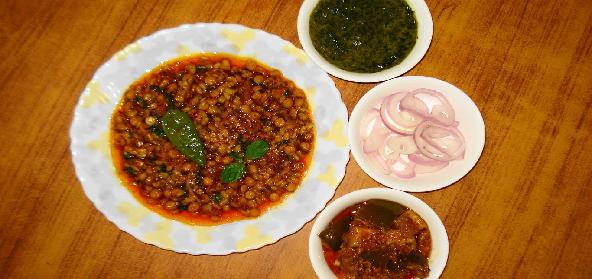Kinema Kya Kehna! A Fermented Feast From the East
Namaste Doston! And a warm Johar to my Sikkimese and Nepali brothers and sisters! Chef Curry Do’pyaza here, back with another dish that’s sure to tantalize your taste buds and transport you to the misty mountains of the Himalayas. Today, we’re diving deep into the pungent and powerful world of Kinema Curry!
This isn’t just any curry; it’s a culinary adventure! For those unfamiliar, Kinema is fermented soybeans, a staple in the cuisine of Sikkim, Nepal, and the Darjeeling region of India. It’s an acquired taste, yes, but once you acquire it, you’ll be hooked!
When Do We Eat Kinema?
Kinema is more than just food; it’s a tradition. It’s especially popular during the colder months, providing warmth and nourishment. You’ll often find it gracing tables during Maghe Sankranti, a festival celebrating the sun’s transition into Capricorn, marking the end of winter and the beginning of longer days. It’s also a common dish during family gatherings and special occasions, bringing people together with its unique and comforting aroma.
A Little Kinema History
Kinema has a rich history, deeply rooted in the agricultural practices of the region. Fermentation was a way to preserve soybeans for longer periods, especially during times when fresh produce was scarce. Over time, it evolved into a beloved ingredient, adding a distinct flavor profile to countless dishes. It is said that the technique was brought into India by the Nepalese and Sikkim people.
Let’s Get Cooking!
Alright, enough chit-chat! Let’s get down to the nitty-gritty of making this delicious Kinema Curry.
Preparation Time: 15 minutes
Cooking Time: 30 minutes
Ingredients:
- 1 cup Kinema (Fermented Soybeans) – You can find this at most Asian grocery stores or online.
- 2 medium Pyaaz (Onions), finely chopped
- 2 medium Tamatar (Tomatoes), finely chopped
- 1 inch Adrak (Ginger), grated
- 4-5 Lahsun (Garlic) cloves, minced
- 2-3 Hari Mirch (Green Chilies), slit lengthwise (adjust to your spice level)
- 1 teaspoon Jeera (Cumin) powder
- 1/2 teaspoon Haldi (Turmeric) powder
- 1 teaspoon Dhaniya (Coriander) powder
- 1/2 teaspoon Lal Mirch (Red Chili) powder (optional, for extra heat)
- 2 tablespoons Sarson ka Tel (Mustard Oil) or any vegetable oil
- Salt to taste
- Fresh Hara Dhaniya (Cilantro) leaves, chopped for garnish
- 1/2 cup water
Instructions:
- Prep the Kinema: If your kinema is in a block, crumble it. Rinse the kinema under running water to remove any excess fermentation residue. Don’t worry about washing away the flavor; it’s already deeply ingrained!
- Sauté the Aromatics: Heat the mustard oil in a kadhai (wok) or a deep pan over medium heat. Once the oil is hot, add the chopped onions and sauté until they turn a beautiful golden brown.
- Ginger-Garlic Magic: Add the grated ginger and minced garlic to the pan and sauté for another minute until fragrant. The aroma will fill your kitchen with warmth!
- Tomato Time: Add the chopped tomatoes and cook until they soften and release their juices, forming a lovely base for the curry.
- Spice It Up: Add the cumin powder, turmeric powder, coriander powder, and red chili powder (if using). Sauté the spices for a minute, ensuring they don’t burn.
- Kinema In The Mix: Add the rinsed kinema and green chilies to the pan. Mix well, coating the kinema with the flavorful masala.
- Simmer and Savor: Add water, salt to taste, and bring the curry to a simmer. Cover the pan and let it cook for about 15-20 minutes, stirring occasionally, until the kinema is tender and the flavors have melded together beautifully.
- Garnish and Serve: Garnish with fresh cilantro leaves and serve hot!
Chef Curry’s Tips for the Best Kinema Curry:
- Mustard Oil is Key: Using mustard oil adds a unique pungent flavor that complements the kinema perfectly. However, if you’re not a fan, you can use any vegetable oil.
- Don’t Overcook the Kinema: Overcooking can make the kinema mushy. Cook until it’s tender but still retains some texture.
- Adjust the Spice Level: Feel free to adjust the amount of green chilies and red chili powder to suit your spice preference.
- Fresh Ingredients: Always use fresh ingredients for the best flavor.
Kinema Curry, Your Way:
- Gas Stove: Follow the instructions above for the most traditional method.
- Induction Stove: Works just as well as a gas stove. Adjust the heat settings accordingly.
- Pressure Cooker: For a quicker version, pressure cook the curry for 2-3 whistles after adding water. Be careful not to overcook.
- Slow Cooker/Crockpot: Combine all ingredients in the slow cooker and cook on low for 6-8 hours or on high for 3-4 hours. This allows the flavors to meld beautifully.
Nutritional Information (approximate, per serving):
- Calories: 250-300
- Protein: 15-20g
- Fat: 15-20g
- Carbohydrates: 10-15g
Serving Suggestions:
Kinema Curry is best enjoyed with:
- Steamed Rice: The perfect accompaniment to soak up the flavorful gravy.
- Roti or Paratha: For a heartier meal, serve with Indian flatbreads.
- Dal Bhat: A traditional Nepali and Sikkimese meal consisting of lentil soup, rice, and vegetables.
Now It’s Your Turn!
So, there you have it! My take on the incredible Kinema Curry. I urge you to try this recipe at home. It’s a fantastic way to explore the diverse and delicious world of Indian cuisine. Share this recipe with your friends and family, and let them experience the unique flavors of the Himalayas. Happy cooking, and remember, every dish tells a story!
Until next time, keep cooking and keep smiling!
Apna Khyal Rakhiye!
Chef Curry Do’pyaza.
